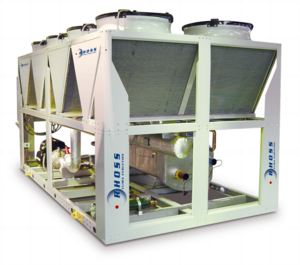What future for R22 chillers?

At least 40% of all refrigeration and air-conditioning equipment in use in the UK operates with R22. With the phase-out deadline for virgin R22 rapidly approaching, and an expected shortfall in the availability and price of reclaimed R22, what are the options for air-conditioning installations using chillers? Steve Warnock reviews them.
At least 40% of all refrigeration and air-conditioning equipment in use in the UK operates with R22. With the phase-out deadline for R22 rapidly approaching, and an expected shortfall in the availability and price of reclaimed R22, what are the options for chillers using R22?
With time now against us and the 2010 deadline only a couple of months away, refrigerant replacement is a quick simple operation that can ensure compliance with minimal disruption. Providing the chiller is in good working order, making a straightforward switch away from R22, will extend its life indefinitely, or at least until it passes the point of economic repair.
The simplest solution, and the best opportunity for your client to make the switch from R22, is when the chiller is being repaired or undergoing scheduled maintenance. This will eliminate the possibility of serious disruption at some less convenient time. When the chiller is being repaired, it is highly likely that the R22 refrigerant will have to be removed, and it might not make sense to reinstall R22.
Following developments in alternative refrigerants, the replacement of R22 is now a straightforward procedure requiring little or no engineering work and, in most cases, no change of lubricants. Replacement refrigerants such as MO99 are designed specifically to replace R22 refrigerant in water chillers. MO99 operates very closely to R22’s cooling capacity and also its performance characteristics. MO99 shows distinct improvements over the other alternatives to R22 currently on the market. The release of this refrigerant follows years of laboratory and global field testing and offers to the building-services sector a tried-and-tested solution to R22 phase out.
Replacing R22 now with this high-performance alternative is an immediate cost-effective solution for commercial and industrial end-users. But, looking to the long term, now is the time for consultants or contractors to start planning future chiller replacements for clients.
With recent technology developments and improvements in chiller design and performance, replacing old chillers with new high-efficiency ones can bring real cost benefits to clients. Replacement can also deliver guaranteed, longer term performance advantages.
However, in a replacement scenario, selecting the most energy-efficient chiller is not necessarily that simple, and there is certainly no one ‘silver bullet’ solution for all applications. As a first step, it is necessary to consider each chiller’s EER (energy efficiency ratio) to obtain guidance on how to proceed.
Eurovent, the European Committee of Air Handling & Refrigeration Equipment Manufacturers, has set its own formulae to calculate EERs, making it easier to compare the performance of chillers manufactured by Eurovent accredited companies. Its classification for full-load EER follows a similar path to the A to G approach to the Energy Labelling Directive, with the energy efficiency of chillers designated by Eurovent A or Eurovent B in catalogues and the Eurovent Directory of Certified products.
A chiller’s EER should not be considered in isolation, however. Reference to the chiller’s ESEER (European seasonal energy efficiency ratio), as set out by Eurovent will allow clients to compare the efficiency of one chiller against another under part-load conditions, the condition at which most chillers will operate at for most of their working life.

Since the compressor is the single, largest energy consumer in any air-conditioning system, the choice of scroll, screw or Turbocor centrifugal chiller is a key factor in defining the EER and ESEER. Chillers featuring oil-free Turbocor centrifugal compressors, with their inverter-driven, permanent magnet motor and magnetic bearings, have recently grabbed plenty of headlines. Typically, traditional induction motors of this size are in the 92% efficiency range, but the Turbocor compressor’s permanent-magnet DC motor provides an efficiency of between 96 to 97%. Yet, they may not be the best option for all applications.
For those tasks requiring cooling capacities up to 350 to 400 kW, chillers with four or six independently operating scroll compressors are still very likely to be the most efficient selection. Matching a reducing load simply means turning compressors off, which is considerably more efficient than allowing compressors to continue to run in an unloaded state
For projects where cooling demand exceeds 500 kW, the choice is probably between a Turbocor or screw chiller. Where load conditions will be constantly above 70%, it is probable that a screw compressor chiller will be just as efficient as a Turbocor one — and considerably less expensive. Where loads are likely to reduce for considerable periods to around 50%, Turbocor chillers will be significantly more efficient than screw.
Common sense needs to be applied when selecting chillers by capacity. The calculated cooling capacity, for example, will very likely include some margin of over capacity. The chiller selected will normally have a slightly higher capacity than the calculated need rather than lower, and the overall selection will be based on the peak load occurring on the hottest day of the year. It is also likely that the selection criteria will be based on an ambient condition of up to 35°C. That may be fine for central London, but for more rural or northerly applications is that really necessary? In other words, in no time at all, clients could be overpaying for an oversized chiller which will cost more to operate and maintain throughout its lifecycle!
In short, for optimum efficiency and reliability, it is better to have a smaller chiller highly loaded than a larger one idling. And with a huge number of installed R22 chillers requiring either an alternative refrigerant or replacement in the next few weeks, end-users need to take advice from their contractor or consultant now to ensure they follow the right course of action.
Steve Warnock is managing director of Coolmation









